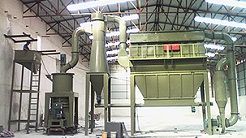Mineral powder grinding mill - ore powder in cosmetics
Source: clirik By Administrator Posted: 2021-07-05Most common ore powder in cosmetics
The link between minerals and cosmetics dates back more than 6,000 years to Ancient Egypt, along with the history of human skunk. The first inventors of cosmetics were the ancient Egyptians, who mixed spices and grease to coat their bodies for pilgrimages and the preservation of corpses. Green peacock stone and blue turquoise are also ground into powder, made into eye shadow for dressing up. From ancient times to the present, mineral composition has been an important raw material for cosmetics.
Talcum powder
In cosmetics, the most commonly used mineral raw material is talcum powder, carefully ground talcum powder is one of the main raw materials of foundation. Its texture is extremely soft, and adding it to cosmetics can make it more delicate. In addition to cosmetics, talcum powder is often used as the main raw material for baby powder.
Talc is a common silicate mineral chemically composed ofMg 3Si4O10(OH)2. In the Mohs hardness meter, talc has a hardness of 1 and is the softest known mineral. Talc is white, dark green, light yellow and many other colors, and it is often mixed with other minerals, such as serpentine and square stone.

Mica powder
For a more sparkling and shiny look, you won't miss cosmetics with pearlic pigments. These shiny cosmetics are inseparable from the help of mica. In ancient China, mica was one of the raw materials for making white pigments, which can be reflected in the painting of Mogao Caves in Dunhuang. In Russia, mica was also used as a substitute for glass to make windows.
Now, the most commonly used in our lives is domo, which is a very common rock-making mineral that can be formed under different geological conditions. Muscovite is a layered silicate mineral chemically 2 of KAL3(Si3AlO10)(OH).
The white cloud mother has a very fine scale-like structure, and also has silky luster is called mica, that is, commonly used in cosmetics mica raw materials. Mica is widely used in makeup and is often used instead of pearlescent pigments for inlet red, loose powder or blush. The name Sericite comes from the Latin selicus, which means silk. Because of its layered crystal structure, the binding between the plates is not strong, so the mica can be divided into thin elastic flakes, and has a shiny luster. This property also makes mica a high-quality raw material for cosmetics.

Bentonite powder
In many masks, bentonite is one of the raw materials. Bentonite is often used as a filler for cosmetics, but also has a certain adsorption of grease and cleaning effect, so it is widely used in cosmetics.
The main mineral component of bentonite is montaturite. Monte stone is a watery layered structure silicate mineral that can be chemically expressed as (Al, Mg 3)(Si4O10)and "OH"2snH2O. Under an electron microscope, montolites appear in a very small scale or fluffy form. When they absorb water, they expand and disperse into a paste. In addition, there are mg2 plus, Na and other cations between the layered structures of Montaigne crystals, which can be exchanged with other cations from the outside world, so Montaigne has a strong adsorption performance and cation exchange performance. This performance makes Montaigne very versatile, and in addition to cosmetics, montaigne is also used in wastewater treatment and paper industry.

How to get these ore mineral powder?
CLIRIK powder grinding mills including vertical mill, ultrafine grinding mill, Raymond mill, high pressure grinding mill etc., all can be used to grinding talc, mica and bentonite. they can also be used to process non-metallic ores such as limestone, calcite, kaolin, and pyrophyllite.
The production of ore powder generally has two steps: crushing and grinding, which requires crushing equipment and grinding equipment.
The versatility of crushing equipment is relatively large. Crushers such as jaw crusher and hammer crusher can be used to crush the above several kinds of ores, but for grinding machines, these ores have their own unique requirements and need to adjust the fineness of the finished powder at will.
The ore powder below 200 mesh can be ground with Raymond mill; the ore powder below 1250 meshes can be ground with high-pressure mill or ring roller mill; the ore powder with 3000 mesh can be ground with superfine grinding and micro-grinding;
General ore powder production equipment consists of hammer crusher, bucket elevator, storage bin, vibrating feeder, micro-grinding host, frequency conversion classifier, double cyclone powder collector, pulse dust removal system, high-pressure fan, air compression It consists of several parts of the machine and electrical control system.
The most important one is the grinding machine host. When we choose, we must be clear about our production needs and choose the most suitable machine. For example, if we only need to grind powder below 200 mesh, there is no need to buy a 3000 mesh micro-powder mill, because its output is relatively low, which will increase investment costs. If you want to produce micro-grinding mills with more than 1250 mesh, you must choose an ultra-fine mill. If you choose a Raymond mill, you will not be able to meet the production requirements.
CLIRIK has been engaged in the field of ore grinding machinery for more than 20 years, and has been focusing on ultra-fine grinding machinery. The independently developed HGM ultra fine grinding mill is sold globally and enjoys a high reputation at home and abroad. CLIRIK grinding mill has stable performance, high efficiency, energy saving and high cost performance. You are welcome to consult us or get more about CLIRIK powder grinding mill.
Related News
- 2021-07-06 13:38:15dolomite powder grinding mill
- 2021-06-22 10:29:40ore mineral grinding mill prices
- 2021-05-19 10:25:55Celebrate the cooperation between our company and Mr. Li (powder grinding mill for glass)
- 2021-03-29 13:43:11Super Fine Powder Grinding Mill Price





